The cardiovascular benefits of High Intensity Interval Training are undeniable, but for many HIIT triggers fear of injury. Incorporating Precovery, Recovery and Self Massage (SMFR) are key for injury prevention.
Change doesn’t happen in a day. In the body, it happens in a millisecond. Each second marks a cascade of countless physiological responses shaped by (and shaping) you and your present moment constitution.
While these reactions aren’t under your conscious control, every step you take exerts real influence. Over time, these ever-changing, infinitesimally small reactions lead to measurable long term adjustments known as adaptations. As we age, these adaptations can be healthy or harmful.
Dr. Jen Fraboni DPT, also known as podcast host and social media sensation Doc Jen Fit, is particularly attuned to the karma of movement and exercise. She reports, “From the age of 25 onward, our aerobic capacity declines 10% each decade.”
This statistic reflects the average, sedentary adult. But your cardiovascular and overall fitness doesn’t have to trend this way. There is something you can do.
“Studies show that HIIT training 3x per week increases this biomarker 12% in only 8 weeks,” says Fraboni.
For those unfamiliar with HIIT, high intensity interval training is a time-effective cardiovascular fitness methodology. HIIT alternates short bursts of vigorous plyometric-style exercise practiced at 80-90% max intensity followed by lower intensity exercise for a number of cycles. “Especially as we age, it’s really important for everyone to continue to do high intensity work,” says Fraboni.
HIIT presents an efficient and exuberant fitness option that promises big benefits for cardiopulmonary health and endurance. Studies show that the overall benefits gained from HIIT are greater than those from moderate-intensity aerobic fitness options, like running, swimming, or dancing.
Evidence-Based Benefits of HIIT
As we age, our body undergoes changes. In addition to the potential decline of your aerobic fitness, the statistical likelihood of disease and mortality rises, especially of cardiovascular disease.
Dr. Fraboni explains that systemic decline begins earlier than you might think, “Sarcopenia, which is the progressive loss of muscle mass that occurs with aging, decreases approximately 3 to 8% per decade after the age of 30.”
However, a fitness routine featuring a well-balanced diet of aerobic exercise, strength training, and restorative practices can shift that outcome and alter your fate.
“Training power is especially important,” Fraboni impresses.
Jill Miller, author of Body by Breath and The Roll Model, shares more on the importance of training power.
There are two types of muscle fibers: Slow twitch muscle fibers, also known as Type I fibers, are designed for endurance activities and are highly resistant to fatigue due to their ability to generate energy aerobically. Fast twitch muscle fibers, on the other hand, known as Type II fibers, are responsible for generating quick, powerful contractions and fatigue more easily.
“Muscle wasting, and specifically fast twitch type muscle wasting is the destiny of the aging body,” adds Miller. “The only way to preserve the fast twitch is to move fast.” Research shows that HIIT trains the Type II fibers associated with agility, strength, and quickness.
 Health and wellness gains from HIIT-style cardiovascular exercise include:
Health and wellness gains from HIIT-style cardiovascular exercise include:
- Improved cardiovascular fitness and aerobic capacity
- Gains in lean muscle mass, strength and tone
- Enhanced muscular endurance and reduced fatigue
- Increased metabolic rate and calorie burn
- Reduced blood pressure
- Improved blood vessel health and compliance
- Improved fat profile with higher HDL and reduced triglycerides
- Reduction in inflammation and oxidative stress
- Improved insulin sensitivity, glucose regulation, and healthy blood sugar levels
- Improved energy efficiency
- Improved lymphatic efficiency
- Improved emotional health / reduction of depression
- Improved cognition and mental processing
The effect of cardiovascular exercise is major, no matter your age. And studies have shown that habitual aerobic exercisers live as much as a decade longer than sedentary individuals.
Cardiovascular Health and Aerobic Capacity
Research indicates that cardio builds your aerobic fitness and overall endurance. Since the 1960s evidence has been reported that “cardio”, known as aerobic exercise in the fitness realm, is especially important for your cardiovascular health, hence the nickname.
Both the Center for Disease Control (CDC) and the American Heart Association (AHA) recommend at least 150 minutes per week of moderate-intensity aerobic activity or 75 minutes per week of vigorous aerobic activity.
During cardio, blood flow shifts to deliver the oxygen required to sustain the increased metabolic activity of active muscle tissue. Over time, your aerobic capacity, also known as your VO₂max increases.
Your VO₂max measures the liters of oxygen delivered by the body to muscles in a state of maximal cardiac output. More simply put, your aerobic capacity represents how efficiently your muscles consume oxygen during intense exercise to produce energy. The more oxygen your muscles consume, the greater your aerobic fitness and overall energy capacity.
The fitter you are, the lower your risk of mortality. A high VO₂max correlates with a low risk of cardiovascular disease, meaning a smaller chance of heart attack, stroke, heart failure, arrhythmias, and valve disease.
Luckily, the measurement is plastic. Your aerobic capacity responds to HIIT training quickly.
Over time, the subtle adjustments your body makes to meet the increased demands of HIIT lead to health-inspiring, long term physiological adaptations. You experience these adaptations as lower resting blood pressure and increased capacity for power.
The benefits of HIIT extend beyond the cardiovascular system, too. It boosts neighboring networks supporting improved endothelial function (aka the executive director of blood vessel function), musculoskeletal system development, lymphatic system flow, cognitive improvement, and mental health.
Your Endothelium and Overall Health
Some researchers attribute poor endothelial function as the root cause behind the development of cardiovascular diseases ranging from hypertension to atherosclerosis.
The endothelium serves as a vital barrier and regulator of various processes such as vasodilation (the widening of the vessels), vascular permeability (to support gas and nutrient exchange), immune response, and the production of nitric oxide (the molecule that widens blood vessels) to maintain vascular homeostasis and support optimal organ function.
Healthy endothelial tissue plays a crucial role in maintaining vascular function, regulating blood flow, preventing clot formation, and supporting overall cardiovascular health. It also underlies mitochondrial health and biogenesis, which stimulates the conversion of fat into energy with greater efficiency. This is why HIIT boosts your fat-burning capacity.
Endothelial dysfunction, on the other hand, means a higher risk of cardiovascular disease and diabetes. It also correlates with certain autoimmune and neurological conditions.
There’s an old adage: Dress in layers to be properly prepared for any condition. Your blood vessels took this advice to heart. Larger blood vessels like arteries feature an outer layer, a mid-layer, and a base layer.
Larger blood vessels possess three single-cell layers of tissue: the tunica adventitia, tunica media, and tunica intima. The tunica adventitia contains nerve cells, the tunica media smooth muscle cells, and tunica intima is lined with endothelial cells. Capillaries have only 1 layer: the tunica intima.
Fascia provides the supporting architecture of the blood vessels, and each layer possesses unique tissues. The thick outer layer is mostly nervous tissue, The middle layer is mostly smooth muscle. The base layer – that is your endothelium.
Evidence shows that HIIT contributes to improved endothelial function. This positive change has a domino effect on all the other systems of the body, contributing to health- and life-span enhancing effects in the metabolic, inflammatory, vascular, cardiac, and nervous system pathways. These micro-level improvements yield macro-level adaptations including improved immune function, bone density, cognitive function and mental health.
Even for those currently living with a heart condition, the effect of HIIT is beneficial for the endothelium. Research also demonstrates a correlation between healthy endothelial tissue and the prevention of atherosclerosis, America’s number 1 killer.
Injury Prevention and HIIT
“It’s only going to benefit your body,” says Fraboni. HIIT underlies health and the exercises can be modified to implement intensity at every age. “My mom is 70 and has always been able to join me for all of my HIIT workouts.”
Nevertheless, not everyone moves forward with her recommendation.
“There’s a lot of fear around HIIT. My clients worry that their joints can’t handle it,” admits Fraboni, “but this is a feasible and safe training option with potential for improving performance, functional, and health related outcomes for older persons, which I think is huge.”
Studies show that there is no increase in incidence of injury for older populations, those living with COPD, Parkinson’s disease, knee osteoarthritis, cancer, or systemic sclerosis. She cautions, however, that proper guidance and preparation are integral to injury prevention. To avoid injury, it is important to warm up, focus on proper technique and form, and progress gradually.
Fraboni’s focus on teaching fitness from a foundation of injury prevention led to her teaming up with Jill Miller on a project released by Tune Up Fitness. ROLL INTO HIIT: Adapting High Intensity for Every Body is a cardiovascular training program they built together based on a Prep, Train, Recover ideology.
To make the program as accessible as possible, the HIIT sequences feature modified and customizable programming options. To help offer personalized training options in a general program, the series opens with two self-assessments to help you self-direct: The MacKenzie Breath Test led by Jill and a PT-inspired Mobility Testing guided by Jen.
This opening step underscores safety by helping you determine your own needs and stick closely to the exercise option that’s perfect for you. ROLL INTO HIIT also adds a novel preparatory step: PREcovery self-massage.
Precovery Techniques to Maximize Your HIIT Workout
“PREcovery is so important!” Miller describes the benefits of the Prep step, “When you roll (aka self myofascial release or self-massage), it improves your body’s ability to sense itself. This sense is called proprioception. Improved proprioception, more easily said, means rolling improves your coordination.”
Miller outlines how proprioception has a protective effect, “Knowing where your body is in space makes you less likely to have accidents and injuries. In the case of HIIT, your brain and body needs to know at speed where your body parts are located to help you get the most out of you movements”
Rolling improves coordination, precision and strength to safely empower you through your faster-paced cardio workout with fewer missteps.
Miller details the science behind the Prep, Train, Recover process, “Rolling also improves the motor unit behavior, which is the neural communication back to the muscle. Once the sensory [nervous system] has been stimulated, then the muscle contraction forces increase. All of the many neural mechanisms are not yet fully understood, but rolling your fascial tissues prior to a workout helps you grow stronger muscles.”
To help avoid injury, each of the therapeutic HIIT segments is complemented by a PREcovery sequence that primes and draws awareness to the specific soft tissues that will be stressed most during the approaching high intensity work. To experience the protective benefits of sharpening your sixth sense, proprioception, have a try at playing with your Toeprioception through this video with Jill.
Toeprioception Toe Self Massage and Rollout
Toeprioception better prepares you for upright exercise and single leg work by heightening the awareness of your soles. Treating your feet allows you to move through your day with enhanced balance and less risk of falling.
One of the most impactful PREcovery rollouts is Tune Up Fitness signature: Coregeous Psoas. The psoas major attaches from the lumbar vertebrae to the high inner thigh, and acts as your prime hip flexor. It also assists with side-bending, external hip rotation, and hip adduction.
Miller points out there’s good reason to activate the psoas before higher intensity movement, “You really don’t want to start exercising with your psoas in a shortened position because that narrows the window of your hip mobility and also compresses the lower back and Sacroiliac (SI) Joint.”
For greatest success in our cardiovascular training, we want to find optimal alignment in the rib-pelvis relationship, she explains, “You can think of the Coregeous Psoas as decompressing the lower back and optimizing the hip range of motion prior to exercise.”
It’s a shrewd strategy to address the factors that contribute to low back pain, which affects an estimated 80% of Americans, before it manifests – and is often a major factor behind why people become more sedentary.
Coregeous Psoas Massage
Opting for this technique holds extra utility when paired with an active HIIT workout like Slider Send Out, which features jumps, bridges, and mountain climbers galore that tax your hip. To help, Coregeous Psoas pre-activates the muscle with a contract / relax technique, one of 8 signature Roll Model Method Rollouts.
“Plus the psoas links to the respiratory diaphragm, and so if we’re over contracted on one side, we’ve got a parachute that’s being over-pulled on one side,” she adds, explaining that’s going to affect posture and breath efficiency.
To support our upright recreation, our daily comfort, and our ease of breath, Miller suggests, “Get the psoas to neutral and then train it once it’s neutral, so that it can, over time, be a better psoas for you”
Recovery Techniques
Post-HIIT session rollouts are intended to help you arrive into a parasympathetic state and replenish the breath more quickly. To switch on your relaxation response, Miller suggests exercises that emphasize the “5 Ps of Parasympathetic Relaxation”: Perspective, Place, Position, Pace of Breath, and Palpation.
Recovery rolling minimizes the stress and fatigue on the body to make today a better day post-workout and prevent future injuries. The Recovery session work also puts you in touch with deep, physiological sensing known as interoception, which helps you listen better to your body and sets you up for improved rest – and ultimately improved adaptations and outcomes over time.
Miller describes the palpable benefits of high level rest and recovery, “When you improve deep sleep by highlighting parasympathetic features, the body spends more time in ‘heal and adapt’ mode. Then the HIIT that you did will show up as new, little baby bursting muscles the next day. Suddenly, this new strength and shape of you emerges through high quality recovery.”
To achieve the quickest results, Miller recommends exercises that feature the Coregeous Ball. She adds, ”Coregeous is simply our most relaxing tool.”
One of Miller’s favorite Recover Rollouts is Coregeous Spirals. This rollout utilizes a Coregeous ball along the side of the rib cage, which nourishes the local soft tissue, including the regions along the serratus anterior, obliques, and intercostals and supports dynamic mobility work.
Miller explains its benefits, “Coregeous Spirals honors ‘the 5 Ps’ in a novel position, working with really slow exhales, eliminating any residual tension that may be left over in your core muscles, and decompressing the ribcage-pelvis-shoulder relationship.”
Coregeous Spirals
This exercise feels especially wonderful for the obliques, lats, and spine. Miller shares, “It creates a really nice traction stretch for all the muscles worked in the preceding sequence, and the diaphragm gets extra support through those deep exhalations.”
“A side position is one of the ways to help babies go to sleep,” she explains the side-lying positioning of the pose. “Body on side tends to ignite a pressure reflex that stimulates your parasympathetic response.”
The rollout enhances cardiovascular wellness by increasing blood circulation, which helps to reduce inflammation and DOMS (delayed onset muscle soreness) to make tomorrow a stronger day, too.
The Cardiovascular Benefits of Rolling
There exists a direct relationship between rolling and cardiovascular health, Jill Miller reminds, “Your fascial tissues are the suspensory highway that allow all of these vessels to exist, move and permit the transportation of your blood. It must be acknowledged as a mechanical and fluid support system for cardiovascular health.”
Rolling supports circulation, improves blood perfusion and angiogenesis (the formation of new vessels). It empowers your muscles to act as a more efficient secondary muscle pump, aiding the heart with circulation.
Miller adds, “Studies have shown that rolling fascia with tolerable friction releases nitric oxide, which supports vasodilation of the arteries (a la healthy endothelial function). It also aids in supporting the contraction of the smooth muscle lining responsible for vasoconstriction.”
Rolling supports blood vessel health overall. The practice deeply touches your heart, too.
“I think there’s a novelty to being able to feel your own heart because we can’t. It’s so well protected. One of the things I love about the Coregeous Ball is that its contact pressure highlights the lub-dub, the sound and sense of your heart’s contractions. There’s something so deliciously alive for me about that heart hug,” says Jill.
Rolling ignites and stimulates the fascia that envelopes and divides, that fills in the intra- and extracellular spaces from the microfilaments of your DNA to each cell, tissue, organ, and system that forms you.
“And don’t forget the direct connection between the heart in its pericardium sitting directly atop the respiratory diaphragm,” Miller reminds.
“We deserve movement medicine,” Miller closes. Strong and true words.
HIIT and rolling are a powerful drug. In his book Outlive, Dr. Peter Attia describes a study performed by Dr. John Ioannidis, a professor at Stanford University: “He found that in numerous randomized clinical trials, exercise-based interventions performed as well or better than multiple classes of pharmaceutical drugs at reducing mortality from coronary heart disease, pre-diabetes or diabetes, and stroke “
Change doesn’t happen in a day, but every healthy adaptation begins with a change. For some, that starts by just rolling with it.
Works Cited
- Attia, Dr. Peter. Outlive: The Science and Art of Longevity. Harmony Books: New York. 2023.
- Félétou M. The Endothelium: Part 1: Multiple Functions of the Endothelial Cells—Focus on Endothelium-Derived Vasoactive Mediators. Morgan & Claypool Life Sciences: San Rafael (CA,: 2011.
- Fernall, Bo and Smith, Denise. Advanced Cardiovascular Exercise Physiology (2nd Ed). Human Kinetics: Champaign, IL. 2023.
- Ma, H et al. April, 2023. “Cardiovascular Health and Life Expectancy Among Adults in the United States.” Circulation (147) 1137–1146
- Marriott et el. (2021) High-Intensity Interval Training in Older Adults: a Scoping Review. Sports Medicine.
- Miller, Jill. Body by Breath. Victory Belt: New York. 2023.
- Strasser, Barbara and Burtscher, Martin. (2018) Survival of the fittest: VO2max, a key predictor of longevity? Front Bioscience.
- Wewege, Michael et al. (2018) High‐Intensity Interval Training for Patients With Cardiovascular Disease—Is It Safe? A Systematic Review. Journal of the American Heart Association.
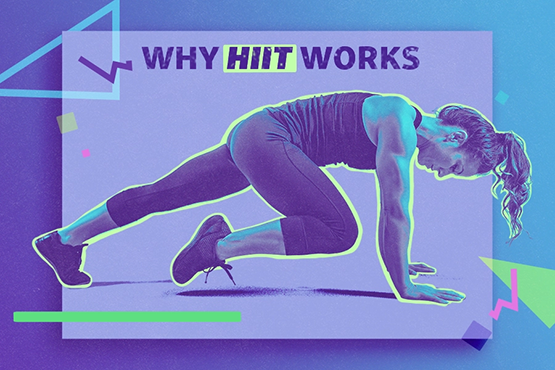
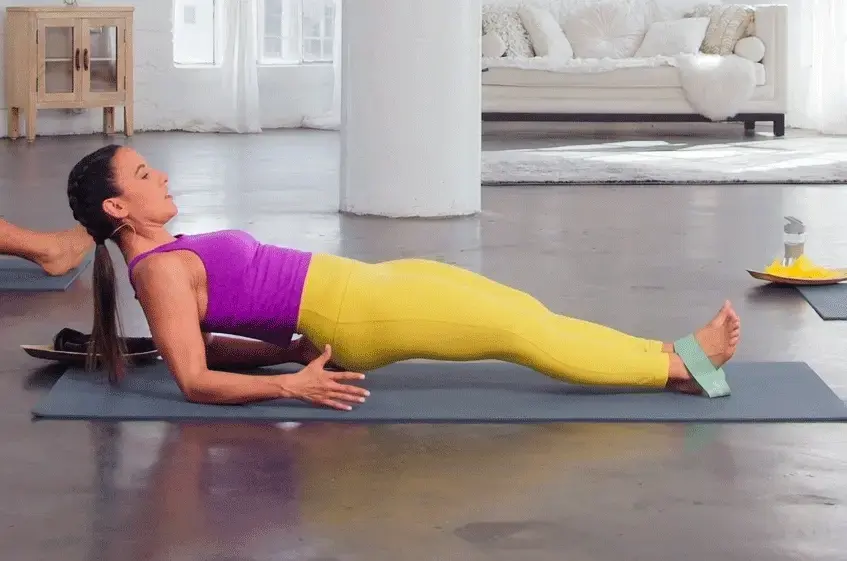
 Health and wellness gains from HIIT-style cardiovascular exercise include:
Health and wellness gains from HIIT-style cardiovascular exercise include: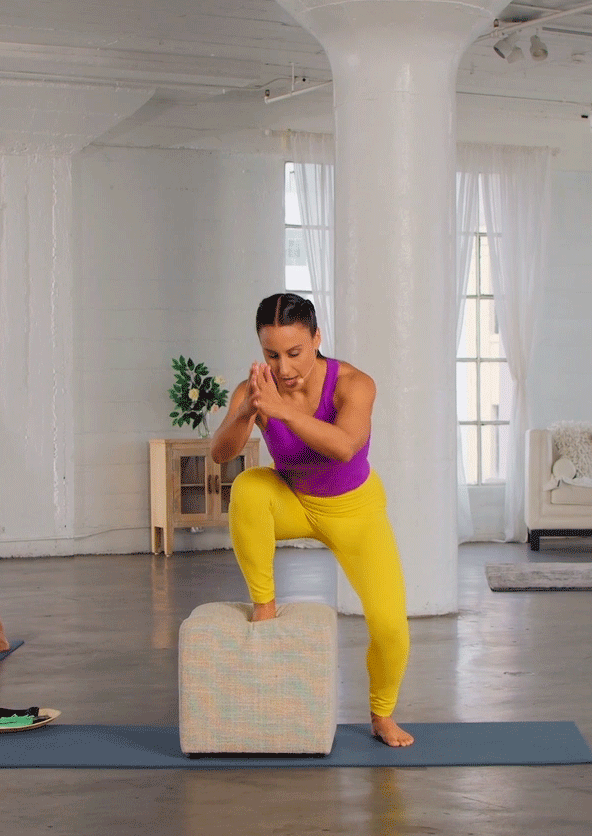







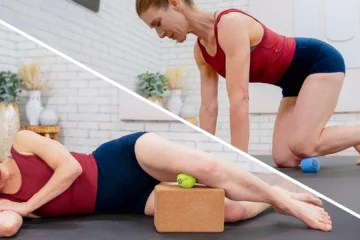
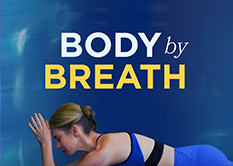



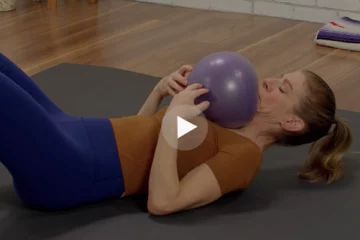
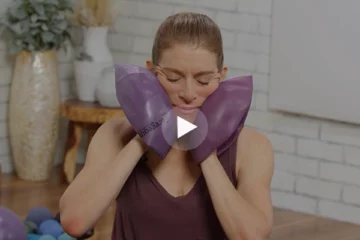


I love this combination of HIT and rolling. I however never appreciated the value until this article. I have experienced increased breath capacity after completing the psoas & coregeous ball exercise. I really like the combination and think it is in alignment with my goals towards injury prevention.
I’ve always been keen of movement in either sports or more recently strength training and yoga practice. I’ve never really adhered to the cardio activities as they felt like I could never get off the energy train. I would stay i the sympathetic state for a lo g time after the exercise until I eventually crashed and was so fatigued. I’m curious to see if incorporating some Coregeous ball activities to get my parasympathetic system in gear would help.
Eager to try these! Thanks 😊
This is such a great informative article – so many things I could mention. Thank you Doc Jen for your explanation of the term VO₂max and how it is measured. I think it was the first time I actually understood it. I did the Roll into HIIT for a while and loved it. I will get back to it as soon as time permits. I love the pre-covery, and I can feel the benefits Jill described. The most interesting part for me was the effect on the endothelial and the cardiovascular system from the fascia perspective, as well as the reflection about the impact of rolling on the health of the cardiovascular system. It feels to me like Jill must have said it through one of the HIIT sessions, because it sounds familiar to me, however, the deep explanation will keep the info stick this time. Thank you both!
Youth is wasted in the young! I am 55 and I learned the hard way that great genes only last so long… I appreciate the knowledge in this article! I didn’t learn about the layers of the tissue in our blood vessels in the anatomy studies I’ve had. This really hit home. I feel like a young student of the body again. stopped my yoga practice for over a decade and it is challenging to get back. My mind is with my body from way back. I am now accepting growing old gracefully and want to be in my best health as well as share with others how they can make that shift as well. I recently started lifting weights with a trainer because I need the help and motivation. In a short time, my body has improved. It reminds me of driving a car, we get in, turn the key and go. I don’t know how the engine works but I drive a lot. Same in my body! There are things I might have a clue, but I don’t know all the important details. The information in this read is targeted and tailored just for where I’m at in life and in my body. This is like opening the hood of my car to get a peek at possibilities and prevention for future injury as well as better sleep. I am excited to jump into this path as well as the yoga tune up balls. Thanks 🙏🏽✨💫
Tonya, you’re such a good writter – so articulate, a wonderful story teller. I especially loved the analogy you made to driving a car and then peeking under the hood. I’m soon going to turn 58 and what you wrote about age and the need to get stronger, more mobile, more knowlegeble and do more activities resonate with me completely. You kinda described my path of the past 8 years. Thank you!
I love this. It makes sense that increased proprioception cultivated in rolling would translate to injury prevention, and the info on direct cardiovascular benefits of rolling is fascinating. I am feeling very inspired to do some HIIT & rolling combos!
I appreciate this evidence-based article on HIIT. I used to do HIIT as a mother to young ones to save time but didn’t find it particularly enjoyable, so I stopped. Now, I feel more motivated to start again! It’s nice to know, now that I am getting older, that I can do this safely with the Roll into Hit program. I was just wondering, how much time is spent precovery and post-HIIT?
I have a love-hate relationship with HIIT and even purchased the Roll into HIIT program to motivate me to get back into it after taking some time to let my plantar fasciitis heal. I really love how the program can be adapted to what your body can do today. I really appreciated how the article outlines a lot of the physiology of the practice and just learned about slow twitch and fast twitch muscle fibers! It was also great to read about the neural communication about rolling before working out, which is something I preach to my students regularly!
I was absolutely one of those that was scared my joints couldn’t take HIIT. I was especially scared of fast, turning/twisting power movements. It was Jen Fraboni’s comment about a 12% increase in cardiovascular health in 8 weeks that got me to look at HIIT again and the understanding that as I age, I’m losing muscle. I’m a newbie in the HIIT realm but I’m already seeing gains in a few short weeks.
This is a great take on HIIT. I really appreciated the breakdown on how both HIIT and SMFR affect the various tissues that make up the cardiovascular system– a really clear case for both intensity and active recovery without the “no-pain, no-gain” approach to movement.
Thank you for sharing this article. I appreciate this article because it highlights the importance of pre and post care of a HIIT workout. An integrated smr component before a workout will yield better movement mechanics, improved alignment and reduced negative stress on the joints. I love the post workout recommendation with the Coregeous ball.
I really enjoyed reading this article and learning the Coregeous Spirals technique. I’m very excited to bring that to my students. HIIT has definitely been my preferred method of cardio fitness for a while so it was very nice to get this addition information that supports its benefits. I’m now very interested in that HIIT and roll corse on here as I don’t often tend to roll before a work out but I do know how tremendously beneficial it can be in recruiting the use of muscle fibers and proprioception.
Really enjoyed reading this article. Looking forward to incorporating some psoas and foot rolling before my next HIIT workout. Also, excited to try the relaxation techniques for after working out. I plan to take the breathe class in the future because I have found in my fitness and self-care journey this is an area I struggle immensely in. I do find the statistical information of how HIIT helps our bodies on a cellular level quite enlightening. Specifically if we think of people in pre-developed times, their “HIIT” would have happened when running/jumping/escaping some type of threat, and then they lived in an active recovery state whenever not in a “HIIT” like scenario. So it makes sense how both HIIT and active recovery are both items our bodies crave and thrive on a cellular level.
This article was a great read. Cardio is not a movement style I’m particularly adapt at and I often struggle to feel integrated when engaged in it. Reading this article really highlighted the benefits of HIIT and reminded me of the need to incorporate it. I’ve practiced the HIIT classes on MBR and enjoyed them and even purchased Roll Into HIIT. I’m determined to go back to these practices and incorporate them into my routine which will in turn make it easier easier for me to tailor these for my students.
I was surprised to learn how beneficial HIIT is. I knew that 10% of muscle mass was lost with every decade after age 30, but it was astounding to learn that 12% could be recovered through the practice of HIIT in about 8 weeks. I also really enjoyed learning the roll out for the psoas using the coregeous ball. The psoas is deep and I could see how this roll out could somewhat access it in the position demonstrated and feel how it helps to soften the entire area. Great article!
Dr. Jen is great! “We deserve movement medicine” – Yes!! I think most of us know some of the benefits of HIIT. However, the combination of PREcovery, HIIT and recovery rolling/massage is a game changer! It is an absolute exploration of ourselves – our bodies and mind. It is like a play between sympathetic and parasympathetic nervous system response which serves as a treat for our health. I rarely do PREcovery before a HIIT session but after reading this article I’m sold. It just makes so much sense that the proprioception we gain thanks to the massage will improve our balance and stability that are crucial for a HIIT session.
Without question, HIIT training has been shown to benefit all age groups! I have been committed to HIIT training for many years in my own training, and this commitment extends also to my clients who perform HIIT training as part of their program. Over time my clients have found that this training helps to create a sense of wellbeing, overall and improves their sleep. Additionally, many report that this training helped to improve their agility, so they were more likely to keep their balance during a “slip and potential fall” event. Considering the statistics around “slip and fall” injuries for the older adult, HIIT training is a critical tool in maintaining optimal health as we age.
This article has convinced me to try Roll into HIIT. As a runner and cyclist, I am really into long, steady state endurance. I have never wanted to go to a gym, be indoors, and do some canned HIIT workout. But – all the benefits of HIIT can’t be ignored, especially as I age – who doesn’t want better cognition?? The Roll into HIIT also looks like fun – an if something isn’t fun, why do it??
I have yet to try the videos. However, the bits about working with older populations and considering injury prevention is just what I need to say/bring to my clients that are fearful about HIIT with COPD, Parkinson’s Disease, knee OA, cancer, or systemic sclerosis. I look forward to checking out “Roll into HIIT.” I’m particularly interested in seeing how self massage can support a client of mine with heart disease- he’s been cleared for exercise but “warming up” into it, may support any fear he may have around it.
Thank you for explaining in scientific but clear terms about how and why HIIT training is so beneficial, especially as we age. There is so much information (and misinformation) out there about what the “best” exercises for an aging population – especially peri and postmenopausal people – are, so many thanks for presenting the latest research. The section on how important the endothelium is and how it functions gave me some great new info. I didn’t realize how important it was, and how HIIT affects it. And as we age, prehab with the Yoga Tune Up and Coregeous balls becomes more essential so that we can prevent injury and stay active.
I did not know about the layers of arteries, and that the outer layer contains nerve cells!
Going to follow this advice and use the Corgeous Psoas for PREcovery before, and Corgeous Spirals after rowing HIIT workouts. So much emphasis is placed on the leg push, but not much is said about mechanism of the hinge backward. Looking forward to improved mobility if not performance by activating the psoas beforehand instead of finally feeling warmed up about 5 minutes into the workout.
Great article and good reminder to revisit Roll into HIIT. Slow and steady workouts have been more my style since getting back into working out after many years, but the cardiovascular benefits of HIIT are undeniable.
I am one of those people who has been wary of HIIT classes because I am afraid of injury. In my 20’s I overdid my workouts and hurt my knees. Now I am 53 and this article “hits” home. I will start taking the HIIT classes on Tune Up Fitness; I love rolling and know the Tune Up approach will be safe. I like the points made about the cardiovascular benefits of rolling…these are good “sell” points to the gym rats who think that it is not worth their time!
Well this article definitely sparks some new curiosity. I do incorporate cardio into my training and also do a ton of YTU rolling but I’m reflecting on the fact that I don’t often combine them into one session and am now very interested in how that will feel. Im actually going to do this program as a mid summer treat later this month! I experience a big mood boost from plyometrics and rich nervous system support from rolling so I’m certain this will be mentally/emotionally a winning combo but as this article points out, it’s also possible to directly improve strength outcomes and that’s something I’m excited to explore. The pieces here about heart health being dependent on healthy, mobile endothelium reminds me of Katy Bowman’s work and it’s wonderful that our understanding and practice of “cardio” is finally expanding into a much fuller picture. I also really love the idea of heart hug and know precisely what Jill is referring to – I also like listening/feeling my heartbeat and to connect that to a HIIT session is creative and inviting!
YTU rolling and HIIT are a winning combination. I appreciate all the science referenced in this blog regarding the benefits of HIIT at any age, but often, high intensity workouts in a body that is not primed for fast movement can lead to injury can sabotage even the best laid plans. Pre and post treatment with YTU balls is the perfect complement to preventing and treating the aches and pains that frequently arise with these workouts.
Thank you for pointing out the necessity of high intensity training. I have often heard over the years that high intensity exercise would spike cortisol levels and increase my chance of injury. The high intensity training and the pre and post- workout Roll Model work (increasing proprioception to reduce injury while working out and calming the nervous system in recovery) seem to me the perfect combination to reap the benefits of both low and high intensity work all in one. Thank you
Great article on so many levels. HIIT was initially billed as a time saver but it’s so much more than than that.
Loved this article for bringing up the benefits of endothelium as a part pf cardiovascular power training. Many people don’t realize that as we age our arteries become more stiff due to myofascial adhesions in the smooth musculature surrounding the arteries, and that this stiffness will lead to hypertension and diminished heart rate variability. I also enjoy being reminded of Jill’s 5 P’s of parasympathetic relaxation
Great article! I highly recommend the “ROLL INTO HIIT”. I find the demonstration of 3 different levels particularly useful.
No wonder HIIT classes are such a hit;) !
This articles lists the benefits of HIIT that go beyond the cardiovascular realm. And I have been one of those people reluctant to participate due to pain and imbalance in my hips. Warming up the body by rolling out especially the psoas is key to prevent injury and provide greater awareness, range of motion and balance between the two sides of the body and the relationship between ribcage and pelvis. I’m looking forward to exploring more HIIT in the future – the benefits are well worth the challenge of the exercises.
Such an informative blog that brings attention to multiple systems in the body that work together to promote function and health. I feel many times we isolate movements or tools and think that they only work on one part of the body but many times, they influence a variety of functions. I particularly liked the emphasis on how rolling affects not only the musculoskeletal and lymphatic system but also nourishes the cardiovascular system by promoting vasodilation of tissues AND the nervous system by learning proprioception…magic!
HIIT is a great way to get the aerobic exercise we need for our heart health. But it’s so common to get sidelined by injuries that could be prevented or easily self-treated with the YTU therapy balls. Everyone should know how to do these simple, self-myofascial release techniques – they would go a long way at keeping us on track with our fitness goals.
Great post. I didn’t realize that muscle mass diminished so much after the age of 30, with a steady decline unless the ‘use it- or lose it’ factor applies here! Thank you for sharing how HIIT workouts do more than just help sustain our muscles, but strengthen our cardiovascular system.
Thank you so much for this article. I’m in my 60s and I need to get my butt going. Good job!